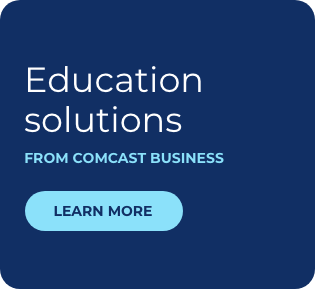5 Trends Impacting the Education Sector

Education today has advanced far beyond the traditional “stand and deliver” pedagogy of years past. Thanks in large part to technology’s influence in the classroom, lecture-based learning environments have given way to collaborative, hands-on experiences that offer richer and deeper learning with greater retention.
Read our white paper and view the infographic.
The education sector was poised to receive $23 billion in technology spending by state and local governments in 2017, just behind health and human services initiatives ($26.4 billion) and ahead of transportation ($10.3 billion), administration and finance ($8.7 billion) and public works
funding ($7.6 billion).[1] Some of that funding can be attributed to an increase in student populations: For the 2017-2018 school year, public school enrollment was expected to be 50.7 million, slightly higher than the 50.6 million enrolled in fall 2016.[2]
That said, the number of teachers is on the decline: Public school systems at the start of the 2017-2018 school year employed about 3.2 million full-time teachers, creating a pupil-to-teacher ratio of 16:1. That is higher than the 15:4 ratio in 2007,[3] which means there are fewer educators for more students. Technology is helping bridge that gap by extending teaching beyond traditional barriers, and thus opening students to new avenues of learning.
TRENDS IN EDUCATION
Indeed, as technology impacts the educational experience, learning becomes interactive, with students actively involved in discovery rather than reading chapters in a book or watching an instructional video. New technologies are bringing learning into the third dimension, as with virtual and augmented reality, while the maker revolution is pushing students to learn by creating.
Five trends in particular— the maker movement, coding and robotics, augmented/virtual reality, personalized learning, and an emphasis on digital citizenship—are fueling a technology-focused learning environment that moves education well beyond today’s experience.
THE MAKER MOVEMENT
The maker movement, a byproduct of the principles of STEAM (science, technology, engineering, art and math), encourages learning by doing, such as building simple computers or other projects. In maker classrooms, students are actively involved in assignments that require them to apply their knowledge and strengths, and then collaborate with other students to achieve a successful outcome. Students are in charge of their learning experience; teachers simply act as guides throughout.
Impacts of the maker movement can be seen both inside and outside the classroom, with “makerspaces” popping up in communities. For example, the Science Museum of Richmond, Virginia, hosts a makerspace it calls the MiX, open to high school students, while the community itself is home to two membership-based makerspaces. That’s in addition to the maker programs in various schools within the school district.
Maker programs celebrate creativity and originality along with knowledge, which can help spark greater interest in STEAM learning overall.
CODING AND ROBOTICS
An important element of STEAM and the maker movement is the emphasis on coding, as students work to develop software and mobile applications. As technology is an integral part of our daily lives, coding is becoming an essential skill as students prepare for the jobs of tomorrow and beyond.
Robotics, too, is growing as an essential skill for students as the internet of things (IoT), advances in machine learning, and other factors are bringing robotics into the mainstream. Students can put their coding skills to the test by creating robotics that perform simple tasks. Robotics is an effective way to introduce students to programming, and teaches them a valuable life skill.
In addition, coding and robotics projects enforce a “computational” mindset, wherein students can use the learning concepts of computer science to solve problems in other subjects such as music or art.[4] For example, using the concept of pattern recognition, students can spot trends in weather to predict hurricanes or blizzards. Computational thinking helps students understand how computing influences the greater world.
AUGMENTED/VIRTUAL REALITY
Of all the technologies touted as the game-changer in education, virtual and augmented reality just may live up to the hype. Virtual reality helps bring students closer to their subject matter simply by strapping on a headset and utilizing hand controls, giving them the chance to ride an elephant or fly over the Great Pyramids of Giza, or even enter a red blood cell. Using the immersive environment of virtual reality, students are able to learn by experiencing through sensory cues such as hearing the crashing of waves on a beach or touching the fur of a wild animal.
Augmented reality, meanwhile, helps students visualize concepts while firmly rooted in the here and now. For example, in a science unit about the human eye, students can use augmented reality to view a 3-D model of the eye, with certain parts highlighted to show how they work together. Or students learning about the Trojan War can use augmented reality to see a scale model of the Trojan horse.
The myriad benefits of virtual and augmented reality—making learning more accessible and resulting in deeper learning and greater engagement—have the potential to make a lasting impact on the way students learn and retain information.
PERSONALIZED LEARNING
The current generation of technologies impacting the educational experience has expanded opportunities for personalized learning. Simply put, personalized learning addresses each student’s learning style and interests for deeper learning through a mix of face-to-face teaching, technology-assisted instruction, and interpersonal collaboration.
There is no set program for personalized learning; rather, schools and instructors develop game plans that are appropriate for the students—including their learning styles—and for the curriculum. For example, in a unit on the human brain, students could receive some of their instruction via online programs, then work in small groups to complete assignments or projects. The students then meet with the teacher to review their work and discuss their overall progress, and the teacher adjusts the program accordingly to ensure students are progressing.
For students who excel with non-traditional modes of instruction, personalized learning can be a highly successful methodology. The collaboration required with personalized learning also can help students improve their teamwork skills—a much-needed skill in today’s job market.
EMPHASIS ON DIGITAL CITIZENSHIP
Our collective dependency on technology has made us all digital natives. Students almost instinctively know how to power up a computer and navigate to a website. Fewer students, however, are being properly schooled on how to use technology safely and effectively.
That is changing, as the threat of online malfeasance grows almost daily. Beyond the danger of predators stalking the internet, students must be made to understand other cyberthreats such as malware, identity thieves and even activity tracking.
The International Society for Technology in Education (ISTE) lists four digital citizenship standards in particular it believes all students should be taught:
- Students cultivate and manage their digital identity and reputation, and are aware of the permanence of their actions in the digital world.
- Students engage in positive, safe, legal and ethical behavior when using technology, including in social interactions online or when using networked devices.
- Students demonstrate an understanding of and respect for the rights and obligations of using and sharing intellectual property.
- Students manage their personal data to maintain digital privacy and security, and are aware of data-collection technology used to track their navigation online.[5]
NEXT-GEN TECHNOLOGIES: HOW THE NETWORK MATTERS
The technologies that have the power to transform education are wide-ranging in their abilities, but all serve the same purpose: to further the educational experience well beyond today’s classroom setting. It may only be a matter of time before preschoolers are coding simple apps and physical field trips are ditched in favor of virtual ones taken by strapping on a headset.
In embracing these next-generation technologies for education, schools and higher education institutions first must prepare their networks to certify they are able to handle the increase in traffic and demand for bandwidth. Virtual reality, maker projects, robotics and other technologies can stress the bandwidth of traditional networks and impact performance.
Educational institutions, therefore, need to ascertain if they have the right foundation for both student-focused and administrative applications and operations, as well as new opportunities yet to be imagined.
In building a network that supports these new technologies, providers should consider an environment that includes both on-premises, cloud, and networking technologies such as SD-WAN and high-speed broadband to make certain traffic is handled efficiently over any type of network. And networking components such as WiFi and unified communications can ensure users of the network—students, educators and administrators alike—interact and transact however and whenever they choose.
To help ease stress on an educational institution’s current network—not to mention the daily burden on the district’s IT manager—managed services can be utilized to offer certain services, such as student management systems, without further impacting the network. Managed services can be used to help tie disparate systems together and “fill in the gaps” as schools and educational institutions update their current infrastructure, and can prove useful even after networks have been upgraded.
Working with a network service provider can help ease the burden associated with building and maintaining a network capable of handling the bandwidth-intensive needs of the technologies powering education today and in the future. By working with a third-party network services provider, schools and educational institutions can leverage virtual and physical private Ethernet connectivity to assure critical applications perform as expected. They also can receive all or some of their most critical connectivity functions as a managed service, including managed connectivity, WiFi, security, voice and business continuity, among others.
CONCLUSION
Education has moved well beyond yesterday’s traditional teaching and learning methods. Technology is a critical component in delivering the new collaborative, experiential, immersive learning pedagogy. As technology serves to further transform education, the burden on the network will continue to grow. Having the right network infrastructure in place to handle increasing bandwidth and data management needs will enable high-quality student interactions and new learning experiences.
View the PDF.
View the infographic: Trends in Education
[1] “State and Local IT Spending Forecast: Education, HHS Top the List,” chart, Government Technology, March 13, 2017 http://www.govtech.com/Stateand-Local-IT-Spending-Forecast-Education-HHS-Top-the-List.html
[2] “Fast Facts: Back to School Statistics, 2017,” National Center for Education Statistics, https://nces.ed.gov/fastfacts/display.asp?id=372
[3] Ibid
[4] Eli Sheldon, “Computational Thinking Across the Curriculum,” Edutopia, March 30, 2017 https://www.edutopia.org/blog/computational-thinking-across-the-curriculum-eli-sheldon
[5] Dennis Pierce, “How to Take Digital Citizenship Schoolwide,” Samsung Insights, Oct. 2, 2016 https://insights.samsung.com/2016/10/05/how-to-take-digital-citizenship-schoolwide/
Education today has advanced far beyond the traditional “stand and deliver” pedagogy of years past.
Locked Content
Click on the button below to get access
Unlock NowOr sign in to access all content on Comcast Business Community
Learn how Comcast Business can help
keep you ready for what's next.











